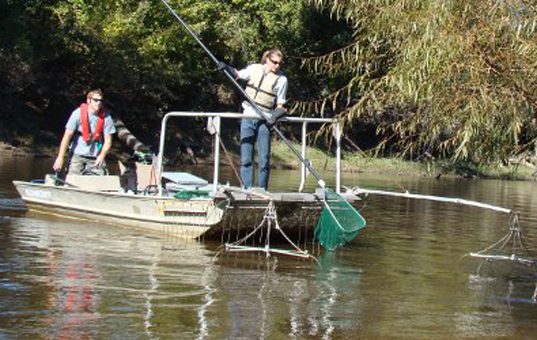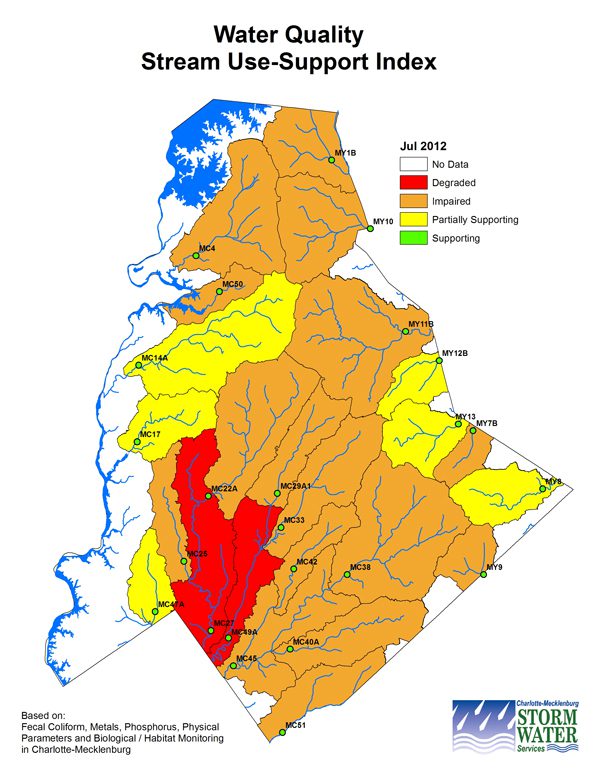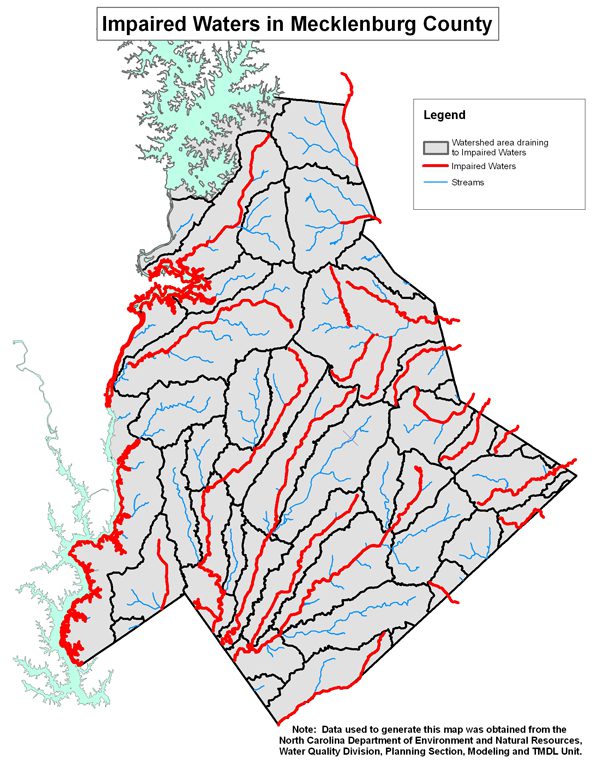How’s the water? Maybe not so fine

Most water quality indicators in Mecklenburg County are “good,” but its streams are not as clean as they should be, says the county’s latest State of the Environment Report. Three of four environmental indicators in this category are rated “good” and either trending up or stable. The fourth, “streams,” is rated “fair” but stable.
|
Read more about report This is the second of four State of the Environment report articles. Others examine land preservation, air quality and waste. |
“The discharge of untreated, undetained runoff from impervious surfaces has the greatest negative impact to surface water quality,” the report states.
The 2012 report from Mecklenburg County’s Land Use and Environmental Services Agency (LUESA) has four categories of water quality environmental indicators:
- Streams, ranked “fair” and stable.
- Groundwater, ranked “good” and stable.
- Lakes, ranked “good” and trending up.
- Public involvement, ranked “good” and trending up.
This series of articles on PlanCharlotte.org is examining the 2012 report. The article on air quality is here. The report is not available in print, but can be found at LUESA’s website.
Surface water quality
In urban and suburban areas, water that runs off dirty surfaces such as buildings, lawns and paved areas is filled with trash, animal waste, chemicals and all sorts of pollutants. The contaminated water rushes into streams through storm drains without passing through the plant cover that would otherwise naturally slow it down and clean it up before it flows downstream. As more water flows, and faster, it adds to stream bank erosion, further degrading the water with sediment and reducing the amount of flow in the stream. Charlotte-Mecklenburg Storm Water Services (CMSWS) recalls a study in 1970 that found fish had vanished from Little Sugar Creek, and that many other Mecklenburg County creeks and popular swimming holes were full of toxic bacteria. A newspaper headline read “The Creek Is Simply a Sewer.” Things are much improved. Fish have returned to local creeks, including Little Sugar Creek, but much work remains to protect the quality of our surface water, our community’s drinking water supply and the drinking water supplies for communities downstream in the Catawba basin.
|
How you can help ► Big Sweep 2012: Volunteers clean trash from creeks and lakes. 9 a.m.-1 p.m. Saturday at sites across Mecklenburg County. No registration needed. |
A combined storm water services division for Mecklenburg County and all its municipalities has been in place since 1993 to enforce ordinances aimed at storm water and protecting water quality. With some 3,000 miles of streams and 3,300 miles of storm pipe in the county, this is no small task. Regular testing of creeks, lakes and the Catawba River shows progress has been made. But in many creeks, bacteria and sediment levels are still higher than state standards.
“In Charlotte-Mecklenburg,” reports the county storm water office, “81 percent of watersheds contain streams which are considered ‘impaired.’ That means they are not clean enough for their intended use, which is recreation.”
The county collects water samples monthly to monitor levels of fecal Coliform bacteria (an indicator of human or animal waste), turbidity (cloudiness), dissolved oxygen, pH (acidity), temperature, total phosphorus, copper, chromium, lead and zinc. Fertilizers, animal waste and other pollutants can cause algae to grow rapidly, which sucks oxygen and sunlight from the water. In addition, chemicals, bacteria and high water temperatures can make water in our lakes and streams too inhospitable to support aquatic life.
The U.S. Environmental Protection Agency lists the number of “impaired waters” by state. North Carolina lies somewhere in the middle of this list with 1,270, compared to nearby Georgia with 215. Pennsylvania leads the nation at 6,957. The county’s environment report says that “based on the Lake Use-Supported Index (LUSI) developed by Charlotte-Mecklenburg Storm Water Services, the overall water quality downstream of Charlotte-Mecklenburg at Lake Wylie is very good; it improves upstream at Mountain Island Lake, and improves still further upstream at Lake Norman.”
 This suggests the water quality is sufficiently clean in the county’s streams and other discharge points for those lakes. However, the 2012 State of the Environment report says our streams have not shown a significant improvement. It lists eight local streams that do not meet what the state of North Carolina has identified as minimum water quality standards in at least one category. Of the eight, Irwin, Little Sugar and McAlpine creeks fail in three categories: fecal Coliform, turbidity and dissolved oxygen. Lake Wylie also fails to meet minimum standards for chlorophyll-a pollution levels, an indicator of high algae growth. Mecklenburg County has created an index to make water quality easier to represent. The map at right shows that index for July 2012. (Click here to learn more about this index). For a recovery plans for impaired streams, click here. Scroll to the bottom of this article to see a map of impaired streams based on section 303(d) of the Clean Water Act.
This suggests the water quality is sufficiently clean in the county’s streams and other discharge points for those lakes. However, the 2012 State of the Environment report says our streams have not shown a significant improvement. It lists eight local streams that do not meet what the state of North Carolina has identified as minimum water quality standards in at least one category. Of the eight, Irwin, Little Sugar and McAlpine creeks fail in three categories: fecal Coliform, turbidity and dissolved oxygen. Lake Wylie also fails to meet minimum standards for chlorophyll-a pollution levels, an indicator of high algae growth. Mecklenburg County has created an index to make water quality easier to represent. The map at right shows that index for July 2012. (Click here to learn more about this index). For a recovery plans for impaired streams, click here. Scroll to the bottom of this article to see a map of impaired streams based on section 303(d) of the Clean Water Act.
Stream restoration projects, water quality recovery programs, and master plans are in place to improve surface water quality in Mecklenburg County. So is a joint project between the state’s Division of Water Quality and Mecklenburg County. The purpose of the joint project is to determine levels in fish tissue of certain organic compounds and heavy metals, including polychlorinated biphenyls (known as PCBs), mercury, arsenic and selenium, in order to better inform the public of potential health risks from eating fish from nearby lakes. Heavy metals, which naturally occur at low levels, are released into the air when fossil fuels such as coal, gasoline or oil are burned. They, along with PCBs, can persist and accumulate in the environment, causing cancer and other health problems. Fish absorb those pollutants through what they eat and by exposure to contaminated water and sediments. The chemicals can build up over time, making it dangerous for people to eat the fish. The study focuses on fish commonly caught and eaten, such as white perch, blue catfish, channel catfish and black crappie.
Keeping groundwater safe
Mecklenburg’s groundwater is rated good, and holding stable. Approximately 15 percent of the county’s residents use groundwater as their primary water supply.
Groundwater is water that finds its way underground through the cracks and spaces in soil, sand or rock. It is stored in aquifers. Groundwater reaches the surface through springs or wetlands and in areas known as aquifer recharge areas. Wells also bring underground water to the surface. Rainfall, absorbed back into the ground, is the main way to recharge the aquifer. The 2012 report says Mecklenburg County has more than 1,300 known soil or groundwater contamination sites, with 256 contaminated wells identified in the vicinity of these sites.
The public has a role
The county and local municipalities have ordinances designed to protect our waters, such as requiring buffers to water bodies and programs for bioretention, rain gardens and other improved storm water practices. These types of measures may help improve and protect our water quality.
Education and citizen involvement are a big part of this, and the report ranks Mecklenburg “good” and getting better.
“Each year,” it says, “hundreds of volunteers help protect and restore Charlotte-Mecklenburg’s creeks and lakes,” through programs such as Adopt-a-Stream and Storm Drain Marking.
Annual events also include Big Sweep and Creek ReLeaf. In 2011, volunteers picked up more than 15,000 pounds of trash from local waterways. Big Sweep 2012 is Saturday (Sept. 29) at various locations across the county.
Through Creek ReLeaf, trees are planted in riparian areas throughout Mecklenburg County. Since 2008, more than 7,000 tree seedlings have been planted in the Briar, McDowell and Little Sugar Creek watersheds. The 2012 ReLeaf will be Nov. 17. To take part, sign up here.
These and similar programs have immediate and long-lasting results for improving local water quality.
Below is a map of impaired streams provided by Charlotte Mecklenburg Storm Water Services.

Under section 303(d) of the Clean Water Act, states, territories, and authorized tribes are required to develop lists of impaired waters. These are waters that are too polluted or otherwise degraded to meet the water quality standards set by states, territories, or authorized tribes. The law requires that these jurisdictions establish priority rankings for waters on the lists and develop TMDLs for these waters. A Total Maximum Daily Load, or TMDL, is a calculation of the maximum amount of a pollutant that a waterbody can receive and still safely meet water quality standards. For more about these requirements, click here.